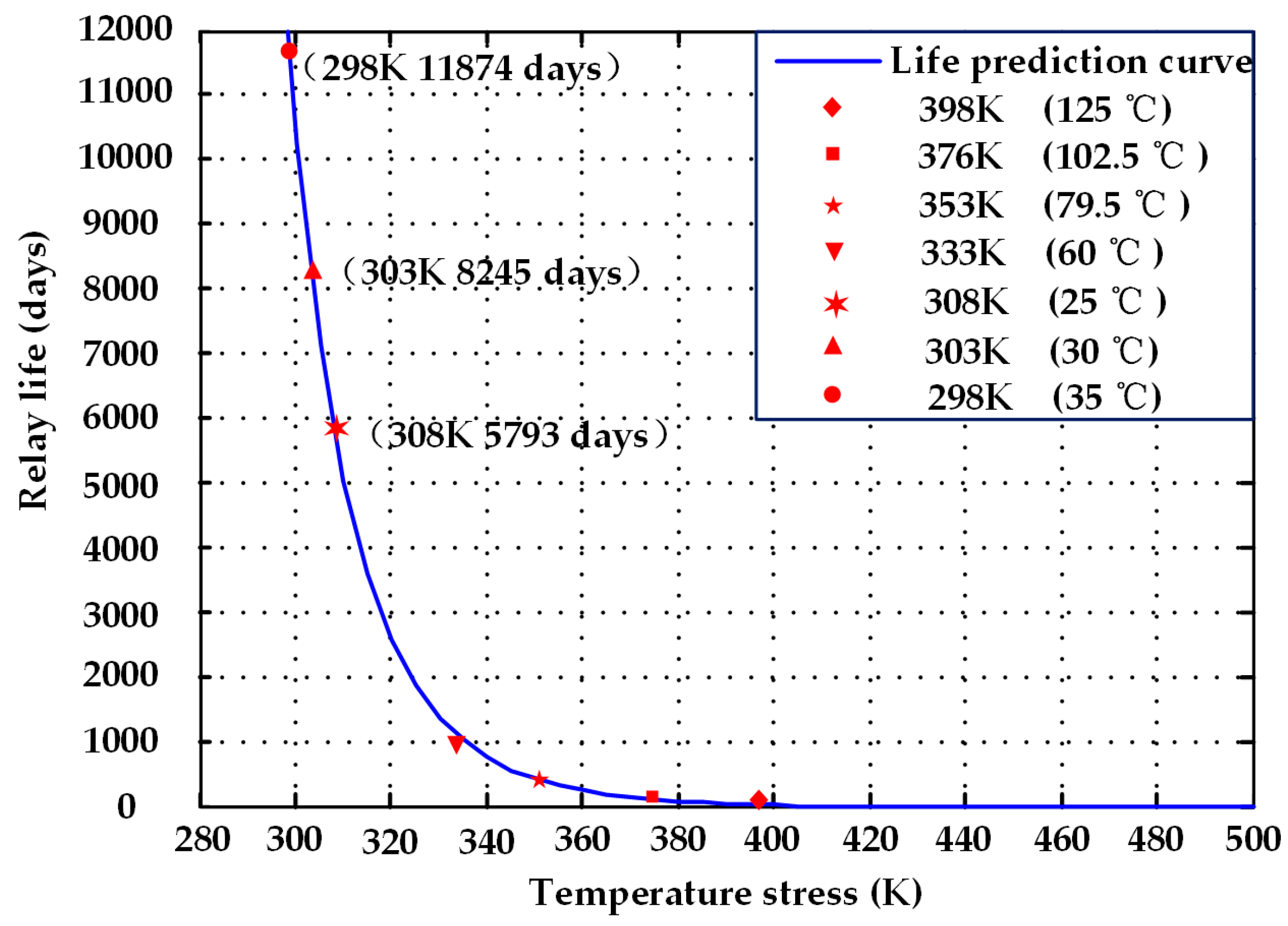1. Introduction
The electromagnetic relay is an automatic switch with isolated function, which is widely used in the high-speed train (HST). With the development of the HST, its safety and normal operation have become very important. The electromagnetic relay is a crucial control element in electronic devices. Relay failure endangers the safety of the HST, and even leads to accidents. Therefore, it is of great significance to study the reliability assessment method for relays.
The reliability assessment method for relays includes the failure mechanism analysis, the establishment and selection of the degradation model, and the accelerated life test. The purpose of the failure mechanism analysis is to determine the characteristic parameters of the relay. The purpose of the degradation model is to describe the changes of the characteristic parameters over time. The accelerated life test is carried out to verify the effectiveness of the reliability assessment method.
Traditional failure mechanism analysis is based on observing the contact surface with the naked eye, or using devices such as the optical microscope [
1,
2]. Using this method, the intuitive failure information is obtained, but shucking the sealed relays is time-consuming, laborious, and sometimes they are even inoperable. To address these problems, some scholars have made investigations into the physical and chemical characteristics of the corrosion film between the contacts. The corrosion film is caused by the diffusion of the contact region [
3,
4]. Most of these investigations have focused on the failure mechanism of the contacts. However, the time parameter is also important [
5]. Therefore, this paper analyzes the failure mechanism of the relay from two aspects: contact resistance and closing time.
There has been much research on reliability assessment methods for aerospace relays in a storage condition [
6,
7]. However, the research on relays in a storage condition is not in accordance with the actual condition in the HST. The research on relays in a work condition is limited. In addition, the degradation model is also proposed in the storage condition [
8,
9]. The analysis of the degradation model is an independent incremental process using the linear mean [
10,
11]. However, because of the impact of the contact material, structural parameters, environmental factors, and the complexity of the failure mechanism, there is substantial difficulty in establishing a precise mathematical model. Therefore, this paper deduces the degradation model for contact resistance and closing time. The optimal degradation model is chosen by the residual sum of squares.
Since no or very few failures occur during the normal test, the relays are highly reliable over a long time period. It is difficult to assess reliability using traditional life test methods in a short time period [
12,
13]. For this reason, a low-cost test method that can be used in a short time period needs to be studied. In recent years, the new method of the accelerated life test based on the degradation parameter has been used widely. This test method has the advantage of shortening the test time, and obtains more information than the traditional accelerated life test [
14,
15]. To date, the method has been used in the areas of aerospace electronics, rolling bearings, and lithium batteries [
16,
17,
18]. However, there is only limited research on relays used in the HST.
The sections of this paper are organized as follows: The failure mechanism is analyzed in
Section 2. A reliability assessment method is proposed in
Section 3. The contact resistance degradation model and the closing time degradation model are derived in
Section 4. In
Section 5, verification of the effectiveness of the proposed method is discussed, with a test platform designed and built to measure contact resistance and closing time using the accelerated life test method. In
Section 6, the optimal degradation model is chosen according to the fitting results. Relay life at four temperature stress levels is predicted using the optimal degradation model and failure threshold. Finally, relay life at ambient temperature is calculated, according to the above life characteristics and the Arrhenius model.
6. Conclusions
In this paper, the failure mechanisms of electromagnetic relays were analyzed from two aspects: contact resistance and closing time. The method analyzed the characteristics of relay life. A reliability assessment method has been proposed. The contact resistance degradation model and the closing time degradation model were derived to establish the mathematical model of relay life. To verify the effectiveness of the proposed method, a test platform was designed and built to measure contact resistance and closing time, using the accelerated life test method. The least squares fitting was used to calculate the residual sum of squares and the unknown parameters in the degradation models from the test data. The optimal degradation model was chosen according to the fitting results. The relay life at four temperature stress levels was predicted using the optimal degradation model and failure threshold of the relays. Finally, relay life at ambient temperature was calculated, according to the above life characteristics and the Arrhenius model. The result indicates that the life of electromagnetic relays at ambient temperature is 11,874 days and that the prediction error is approximately 5%. The reliability assessment method provides important guidance for the maintenance of electromagnetic relays. In addition, the method can save maintenance time, reduce maintenance costs, and can be easily generalized to other types of HST.
















